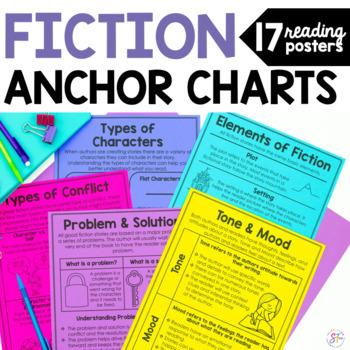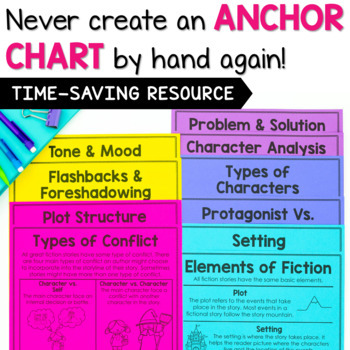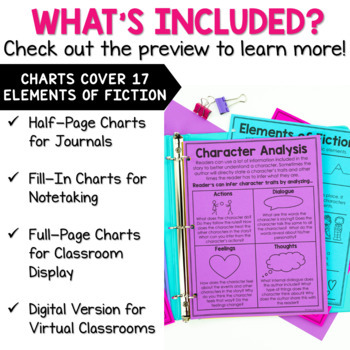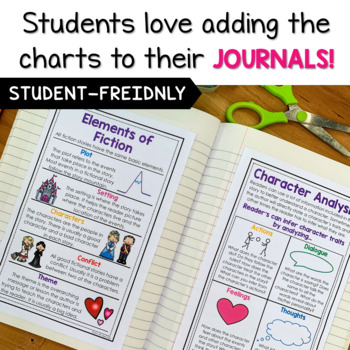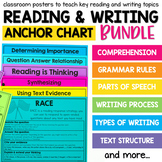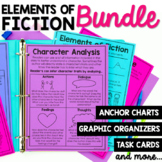Story Elements of Fiction Posters and Anchor Charts
- Zip
What educators are saying
Also included in
- How would you like to save time and never have to create an anchor chart by hand ever again??? Get a full year's worth of Anchor Charts that are ready to print and use! This ready-to-print bundle includes over 350 anchor charts to help you teach some of the key reading, writing, grammar, and vocabulPrice $52.50Original Price $60.54Save $8.04
- How would you like to save time and never have to create a reading anchor chart by hand ever again? Get a full year's worth of Reading Anchor Charts that are ready to print and use! This ready-to-print bundle includes over 125+ reading anchor charts to help you teach some of the key reading skills tPrice $26.00Original Price $26.52Save $0.52
- Help your students learn all about story elements and how to read and understand fictional texts. This bundle includes anchor charts, graphic organizers, reading task cards and word wall cards that will help you effectively teach your fiction unit. Check out each individual resource included to learPrice $19.50Original Price $25.09Save $5.59
Description
If you teach 3rd, 4th, or 5th grade more than likely you have to teach your students to understand elements of fiction that go beyond just identifying the characters, setting, and plot of a story. If you really want to help your students understand fiction texts, then you need to dig deep into the elements of fiction. These elements of fiction anchor charts and posters will help your students remember all the key story elements and as an added bonus these posters are a great addition to an interactive reading notebook.
This set of anchor charts will be your teacher bestie when it comes to teaching elements of fiction. These posters provide a student-firiendly definition and explanation of a key element of fiction. With the help of these posters, your students will remember and understand the key elements of fiction.
And let’s be honest…sometimes teaching reading in upper elementary can be challenging even for teachers. There are so many vocabulary terms and details associated with understanding fiction texts from knowing the difference between a protagonist and antagonist to understanding the four types of conflict to knowing how to communicate tone and mood. There is a lot of information that even teachers need to research and study before teaching a lesson.
Having a ready-to-print anchor chart that explains and defines key elements of fiction terms to help us our students can be a huge lifesaver. These anchor charts will take the guesswork out of your teaching and serve as the backbone to your unit on the elements of fiction.
HERE’S WHAT YOU GET:
In this resource, you’ll get 17 Elements of Fiction Anchor Charts formatted in the following ways:
- Half-page anchor charts - perfect for students journals (black & white and color options)
- Full page anchor charts - works great for whole group lessons (black & white and color options)
- Digital version - created using Google Slides
- FIll-in version - available for both the half-page and full-page versions and are great if you want your students to take notes during the lesson
LOVED BY BOTH TEACHERS AND STUDENTS:
Your students will love having access to these anchor charts during the year. They won’t feel the pressure to remember all the different vocabulary terms connected to understanding fiction texts because they know they can look back in their journals anytime they need a reminder.
You’ll love these anchor charts because they have easy-to-read font and are written with clear and concise language. Your students will understand all the elements of fiction with these anchor charts.
So many upper elementary teachers love these anchor charts because they aren’t cluttered with excess clipart or fonts that are too “cutesy”.
And, you have options. You can choose to print them in half pages for students to glue in their journals… or you can share them with your students in Google Classroom… or you can give students the fill-in version so they can take notes during your lessons. You can pick the version that will work for you and your students.
Prep is quick and easy... Just print the anchor chart option you want to use before your lesson and you’re ready to go.
ANCHOR CHART TITLES INCLUDE:
- Elements of Fiction
- Setting
- Protagonist vs. Antagonist
- Types of Characters
- Character Analysis
- Problem & Solution
- Types of Conflict
- Plot Structure
- Exposition
- Conflict
- Rising Action
- Climax
- Falling Action
- Resolution
- Dialogue
- Flashbacks & Foreshadowing
- Tone & Mood
HOW TO USE THESE CHARTS IN YOUR CLASSROOM:
- Use as a model for your whole group lessons.
- Give students a copy to glue in their journals.
- Send home a copy to parents to keep them informed.
- Include a copy with your lesson plans to show your administrators what you’re teaching.
- Put posters on a ring or in a binder as a reference for small groups or workstations.
TEACHERS LIKE YOU SAID:
⭐️⭐️⭐️⭐️⭐️ “These are great anchor charts and I love the many options for printing. The students use the 1/2 sheets in their resource notebooks while the colored horizontal charts are great on the reading board. I actually used these both for distance learning and in the classroom when we returned to school.” - Nancy B.
⭐️⭐️⭐️⭐️⭐️ "This was a great resource to quickly review story elements with my students. The visuals were helpful for many of my special education students. The definitions were easy for my students to understand.!” - Carol B.
⭐️⭐️⭐️⭐️⭐️ “These are great reference posters for my classroom! I have them posted year-round and constantly have my students refer to them for more information.” - Elizabeth R.
⭐️⭐️⭐️⭐️⭐️ “Awesome resource and I love the various printing options. Students add a copy to their journals for later review. Thank you!” - Margarita P,
_______________________________________
⭐️ BUNDLE & SAVE FOR A DISCOUNT⭐️
Purchase the Elements of Fiction Bundle to get this set of posters plus Task Cards, Graphic Organizers, Journal Tabs, and a Word Wall. All these resources combined will help you teach a stellar fiction unit.
I THINK YOU MIGHT ALSO LIKE:
→ Reading Skills Anchor Charts
→ Picture of the Day - Elements of Fiction Bundle
________________________________
Copyright © The Stellar Teacher Co. LLC
www.stellarteacher.com
Permission to copy for single classroom use only.
Please purchase additional licenses if you intend to share this product.

